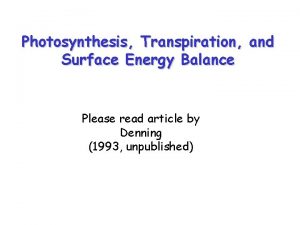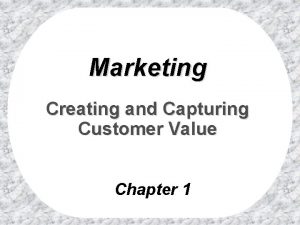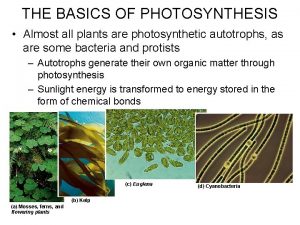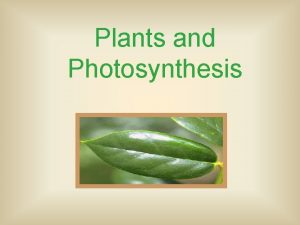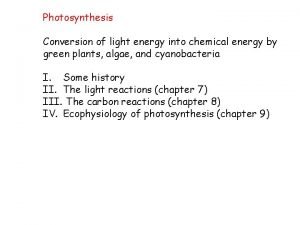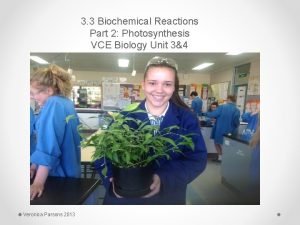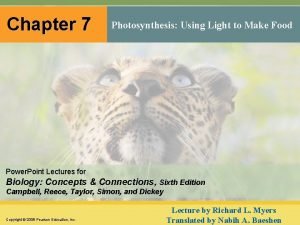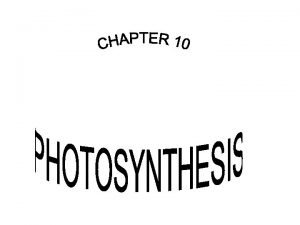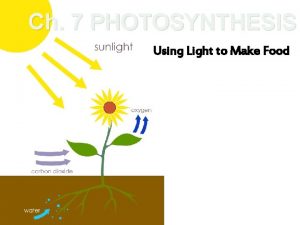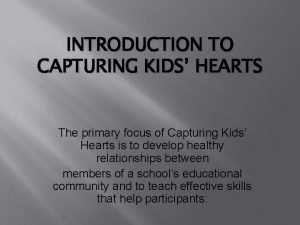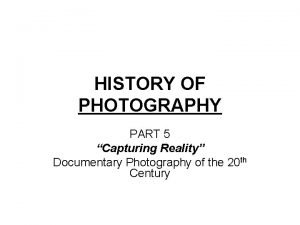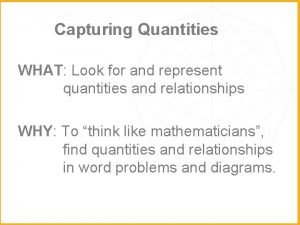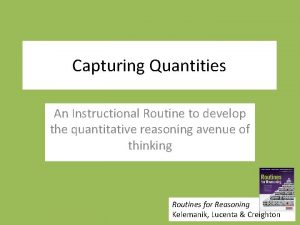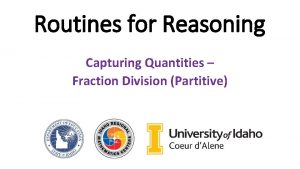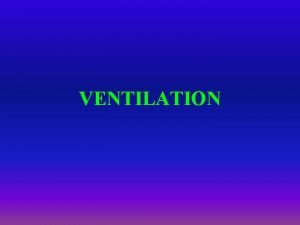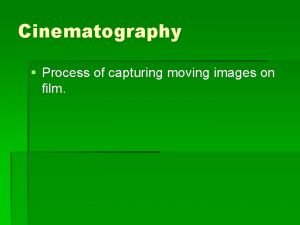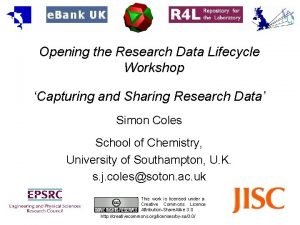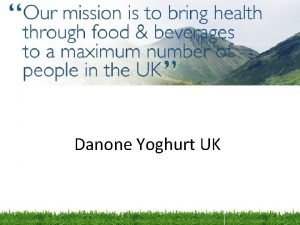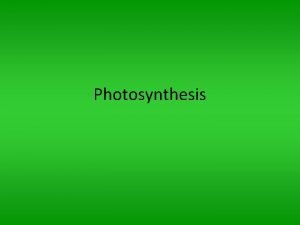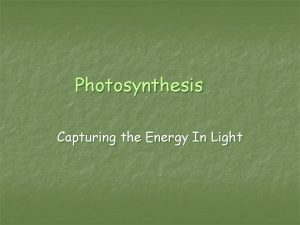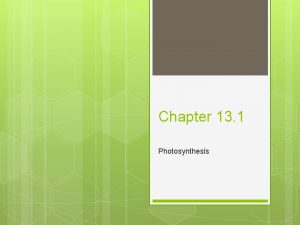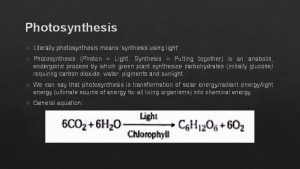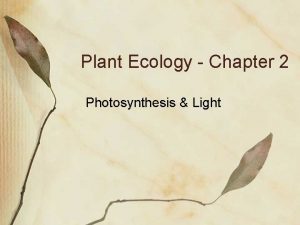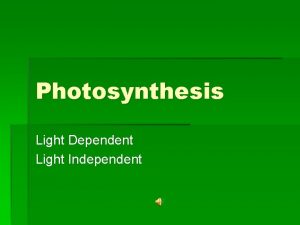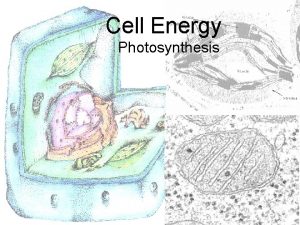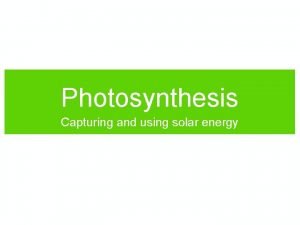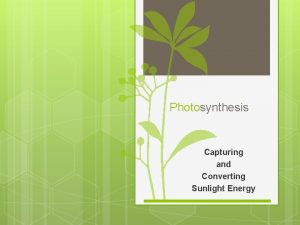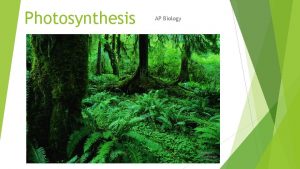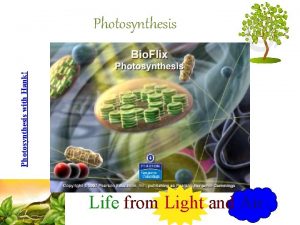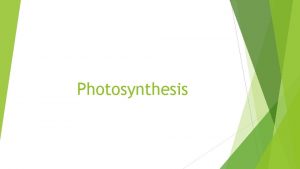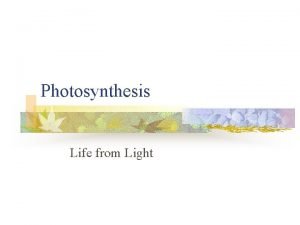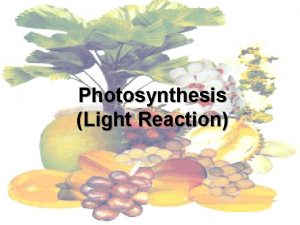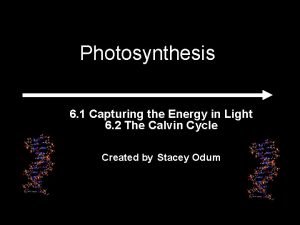PHOTOSYNTHESIS Photosynthesis Life from Light and Air CAPTURING





































- Slides: 37

PHOTOSYNTHESIS

Photosynthesis: Life from Light and Air

CAPTURING THE ENERGY IN LIGHT n n The process by which organisms obtain energy directly from sunlight is called photosynthesis. CO 2 + H 2 O → C 6 H 12 O 6 + O 2

ENERGY FOR LIFE PROCESSES Autotrophs: most Plants, Algae, and some Bacteria. n Autotrophs store energy in various organic compounds, primarily carbohydrates. n

The Basic By Mc. Graw Hill Photosynthesis involves a complex series of chemical reactions: Biochemical Pathway n Products used in cellular respiration in both plants and animals. n


Redox Reactions: OIL RIG Oxidation is Loss Reduction is Gain (of e-) or Oxidation is loss of hydrogen. Reduction is gain of hydrogen.

How are they connected? Heterotroph and…. glucose + oxygen carbon + water + energy dioxide C 6 H 12 O 6 + 6 O 2 6 CO 2 + 6 H 2 O + ATP oxidation = exergonic carbon + water + energy glucose + oxygen dioxide 6 CO 2 + 6 H 2 O + light C 6 H 12 O 6 + 6 O 2 energy Autotroph reduction = endergonic

What does it mean to be a plant n Need to… n collect light energy n n glucose n transform it into chemical energy store light energy n in a stable form to be moved around the plant or stored need to get building block atoms from the environment n n ATP C, H, O, N, P, K, S, Mg produce all organic molecules needed for growth n carbohydrates, proteins, lipids, nucleic acids CO 2 N K P … H 2 O

LIGHT ABSORPTION IN CHLOROPLASTS Light Reactions or Light Dependent Reactions n They begin with the absorption of light in chloroplasts. n Review of the Light Reaction With All Details!

CHLOROPLASTS

LIGHT AND PIGMENTS

chlorophylls accessory pigments carotenoids

Photosynthesis gets energy by absorbing wavelengths of light. Accessory pigments with different structures absorb light of different wavelengths: chlorophyll a & b, carotenoids, xanthophylls, antenna pigments

What is Photosynthesis? n Light reactions n light-dependent reactions n convert solar energy to chemical energy n n ATP & NADPH Calvin cycle light-independent reactions n sugar building reactions n n uses chemical energy (ATP & NADPH) to reduce CO 2 & synthesize C 6 H 12 O 6 It’s not the Dark Reactions!

Virtual Cell Photo.

LIGHT REACTIONS ELECTRON TRANSPORT CHAIN: PHOTOSYSTEMS II AND I. 1. 2. 3. chlorophyll a P 680 = absorbs 680 nm wavelength red light chlorophyll b P 700 = absorbs 700 nm wavelength red light Photosystem I REPLENISHING PHOTOSYSTEM II Go to: D-Drive Youtube Streaming Video CHEMIOSMOSIS Photosystem I file b Virtual Cell: Photosynthesis

ELECTRON TRANSPORT CHAIN The Basic Biochemical Pathway

RESTORING PHOTOSYSTEM II

CHEMIOSMOSIS

What is Photophosphorylation? cyclic photophosphorylation NADP NONcyclic photophosphorylation ATP

Why Cyclic Phosphorolation? n Calvin cycle uses more ATP than NADPH 18 ATP + 12 NADPH 1 C 6 H 12 O 6

PUTTING IT ALL TOGETHER Overview Of the Light Reaction Review of the Light Reaction With All Details!

Photosynthesis Animation n http: //www. stolaf. edu/people/giannini/flashani mat/metabolism/photosynthesis. swf

Experimental evidence n Where did the O 2 come from? n radioactive tracer = O 18 Experiment 1 6 CO 2 + 6 H 2 O + light C 6 H 12 O 6 + 6 O 2 energy Experiment 2 6 CO 2 + 6 H 2 O + light C 6 H 12 O 6 + 6 O 2 energy Proved O 2 came from H 2 O not CO 2 = plants split H 2 O!

Photosynthesis summary Where did the energy come from? Where did the electrons come from? Where did the H 2 O come from? Where did the O 2 go? Where did the H+ come from? Where did the ATP come from? What will the ATP be used for? Where did the NADPH come from? What will the NADPH be used for?

So where does CO 2 fit in? How do plants use it? Why do they need it?

LIGHT INDEPENDENT to the Dark REACTIONS Welcome Side, Lord Calvin n n KNOWN AS THE CALVIN CYCLE = C 3 Photosynthesis. do CO 2 IS FIXED INTO ORGANIC How Plants Capture COMPOUNDS: CARBON FIXATION. CO 2? THREE MAJOR STEPS, WHICH OCCUR WITHIN THE STROMA. Reduction Reaction= C gains H+ Calvin Cycle

P. S. The Dark Cycle Does Not Happen in the Dark It is dependent on the products of the light reaction (ATP and NADPH) So when the lights go out…it has no energy to continue. NOVA Capturing C


Think… n Why can’t we blow carbon emissions into forests and solve global warming?

ALTERNATIVE PATHWAYS TO FIX CARBON n n These alternative pathways are generally found in plants that evolved in hot, dry climates. Stomata: passageways FOR CO 2 and O 2.

C-4: Photosynthesis n n Intense Sunlight and Hot (e. g. corn and crabgrass) Stomata are Partly Closed During Day= CO 2 falls and O 2 rises n n n We don’t want photorespiration. In the Mesophyll PEP carboxylase grabs CO 2 not O 2. Sends CO 2 to the Calvin cycle

The C 4 Pathway FIXES CO 2 INTO A FOUR CARBON COMPOUND OXALOACETATE. HENSE THE NAME: C 4 n Oxaloacetate in the mesophyll turns into Malate, an acid. n Malate is shipped through plasmodesmata into bundle sheath cells and release CO 2 n Calvin Cycle Starts n

The CAM Plants Crassulacean Acid Metabolism n n n Adaptation to Dry Conditions Stomata Closed during Day Open at Night Mesophyll stores CO 2 at night Makes Sugar during Day All 3 (C 3, C-4, and CAM) use the Calvin Cycle

The CAM Pathway n Plants that use the CAM pathway open their stomata at night and close them during the day—just the opposite of what other plants do.

RATE OF PHOTOSYNTHESIS Review
 Light light light chapter 23
Light light light chapter 23 Light light light chapter 22
Light light light chapter 22 Chapter 22
Chapter 22 Hubungan air dengan tanah
Hubungan air dengan tanah Light and dark reactions of photosynthesis
Light and dark reactions of photosynthesis Pricing understanding and capturing customer value
Pricing understanding and capturing customer value Creating and capturing customer value
Creating and capturing customer value Marketing concept
Marketing concept Creating and capturing customer value
Creating and capturing customer value Capturing value from customers
Capturing value from customers Inputs of light reactions in photosynthesis
Inputs of light reactions in photosynthesis Granum
Granum Chemical form of energy
Chemical form of energy Light dependent phase of photosynthesis
Light dependent phase of photosynthesis Chapter 7 photosynthesis using light to make food
Chapter 7 photosynthesis using light to make food Photorepsiration
Photorepsiration Photosynthesis transforms light energy into chemical energy
Photosynthesis transforms light energy into chemical energy Photosynthesis using light to make food
Photosynthesis using light to make food Capturing kids hearts four questions
Capturing kids hearts four questions Capturing marketing insights examples
Capturing marketing insights examples Capuring
Capuring Capturing kids hearts four questions
Capturing kids hearts four questions A device used for capturing images
A device used for capturing images Capturing reality documentary
Capturing reality documentary Measuring sources of brand equity
Measuring sources of brand equity Capturing quantities
Capturing quantities Capturing quantities
Capturing quantities What is data capturing with example
What is data capturing with example Asr in architecture
Asr in architecture Capturing quantities
Capturing quantities Enclosing hood
Enclosing hood The process of capturing moving images on film
The process of capturing moving images on film Research data lifecycle
Research data lifecycle Marketing information system kotler
Marketing information system kotler Swot analysis of sari sari store
Swot analysis of sari sari store Automatic data capturing devices
Automatic data capturing devices Put out the light and then
Put out the light and then Membrane-bound organelles
Membrane-bound organelles




